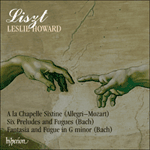In the case of
J. Seb. Bachs Orgel Fantasie und Fuge in g-moll—Für Pianoforte gesetzt von Franz v. Liszt Liszt approached the work quite differently. He adds a number of dynamic marks, tempo directions, pedal directions and a certain amount of phrasing. This was possibly at the request of its dedicatee, Sigmund Lebert, the famous piano pedagogue, who may have feared that the average piano student would not know how to cope with a score unadorned by such indications. The piece was certainly published in the Lebert and Stark Piano School. In the revised edition (recorded here), at four places in the Fantasia Liszt suggests an alternative extra voice in place of rests, in no way intending to improve upon Bach, but attempting to recreate the grandeur of this most powerful work by reinforcing the texture.
from notes by Leslie Howard © 1991
En ce qui concerne
J. Seb. Bachs Orgel Fantasie und Fuge in g-moll—Für Pianoforte gesetzt von Franz v. Liszt, Liszt traita l’ouvrage de façon tout à fait différente. Il ajoute des marques de dynamique, des consignes de tempo, des directions pour la pédale et un certain nombre de phrasés. Il est possible que ce soit à la demande de celui à qui l’ouvrage est dédié, Sigmund Lebert, célèbre pédagogue de piano, qui craignait peut-être que l’étudiant moyen de piano ne puisse venir à bout d’une partition où ne figurait aucune de ces indications. Le morceau a certainement été publié dans l’école de piano Lebert et Stark. Dans la version revisée (qui est enregistrée ici) Liszt suggère en quatre endroits une voix supplémentaire comme alternative possible pour les silences, non pas dans l’intention de faire mieux que Bach, mais pour essayer de recréer la grandeur de cette œuvre si puissante en renforçant sa texture.
extrait des notes rédigées par Leslie Howard © 1991
Français: Alain Midoux
Im Falle von
J. Seb. Bachs Orgel Fantasie und Fuge in g-moll—Für Pianoforte gesetzt von Franz v. Liszt ging Liszt insofern völlig anders ans Werk, als er eine Reihe von Dynamik-, Tempo- und Pedalanweisungen sowie einige Phrasierungen hinzufügte. Dies geschah möglicherweise auf Wunsch von Siegmund Lebert, dem das Werk gewidmet ist. Lebert, ein berühmter Klavierlehrer, mag befürchtet haben, daß der durchschnittliche Klavierschüler nichts mit einer Vorlage anzufangen wisse, in der solche Angaben fehlen. Jedenfalls wurde das Stück in der Klavierschule von Lebert und Stark veröffentlicht. In der (hier aufgenommenen) bearbeiteten Fassung schlägt Liszt als Alternative an vier Stellen in der Fantasia eine zusätzliche Stimme anstelle der Pausen vor, was nicht als Verbesserung Bachs gedacht war, sondern lediglich als Versuch, durch Stärkung der Struktur die Erhabenheit dieses höchst eindrucksvollen Werks nachzuvollziehen.
aus dem Begleittext von Leslie Howard © 1991
Deutsch: Anne Steeb/Bernd Müller


 Liszt: Complete Piano Music
Liszt: Complete Piano Music Liszt: The complete music for solo piano, Vol. 13 - À la Chapelle Sixtine
Liszt: The complete music for solo piano, Vol. 13 - À la Chapelle Sixtine
